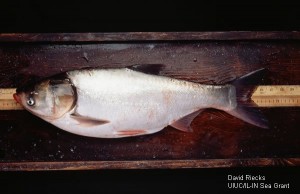The discovery of additional silver carp and big head carp in East Lake Okoboji this week is further evidence supporting the need for an electric fish barrier.
The Iowa Department of Natural Resources issued a news release on Wednesday stating that a commercial fishing company caught 55 silver carp and 82 big head carp in late March, fishing in the same general area of East Okoboji Lake where two big head carp were netted by the Iowa DNR last August during a population survey. A few additional carp were caught this week.
“This just shows how right we were in moving forward with the fish barrier fund raising,” says Phil Petersen, Executive Director for the Iowa Great Lakes Association. “We are raising the money. Fortunately the DNR is already moving through the bid process to have the Electric Fish Barrier constructed. Now we need to encourage the DNR to move faster to construct the Electric Fish Barrier.”
Studies show high water events have allowed this invasive species to find its way into the Iowa Great Lakes.
Mike Hawkins, fisheries biologist with the Iowa Department of Natural Resources, said the invasive fish had a small window last summer in which to enter the Iowa Great Lakes. Flood events in June and July allowed the fish to navigate the Little Sioux River past the Linn Grove Dam, landing at the doorstep of the Iowa Great Lakes.
Once below the Iowa Great Lakes, heavy rain events in July caused flooding conditions on the lakes that allowed these fish to enter Lower Gar Lake, which is the final lake in the chain of six glacial lakes in Dickinson County.
“While it confirms the presence of both species, this commercial seine haul does not tell us how many Asian carp are in the lakes. Nor does it get us any closer to knowing at what level these fish will be a problem,” Hawkins said.
Hawkins added that ecologically, these fish are not likely to reproduce here because studies show they prefer large rivers for spawning. However installation of the electric fish barrier is needed to keep additional carp from reaching the lake via Mill Creek.
“Mill Creek is low due to the dry weather, so we don’t have additional Asian Carp getting in right now,” adds Petersen. “How long Mill Creek remains too low for Asian Carp to migrate here remains to be seen.”
Stacy Rosemore, director of Okoboji Tourism, spoke with KUOO radio and urged residents not to overreact to the announcement.
“At this point, there is no need for alarm,” said Rosemore. “There’s no need to sell your boats or to quit boating on our lakes or to quit vacationing on our lakes because we are in the early stages and we’re still learning about this as well. No need to panic and we’re looking forward to another great summer.”
Rosemore, Hawkins and Petersen all urge continued support of the electronic fish barrier to prevent further invasion of these carp species in the Iowa Great Lakes.

